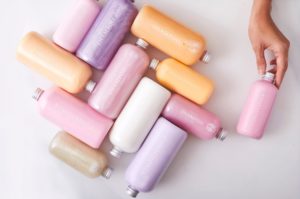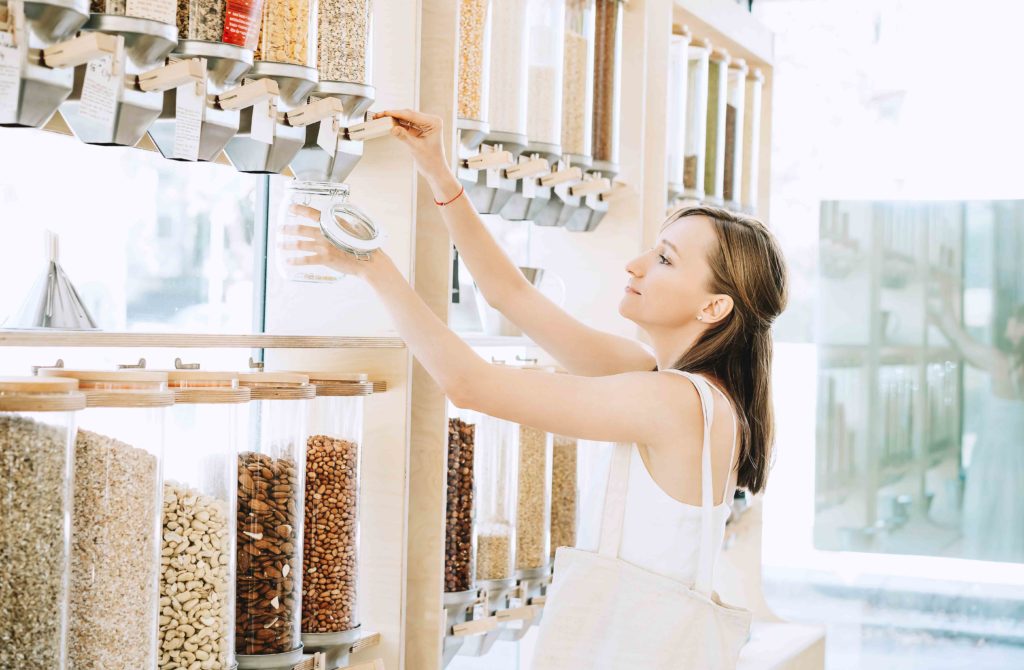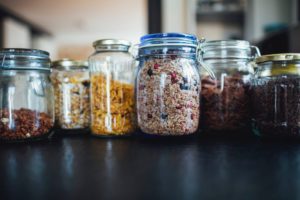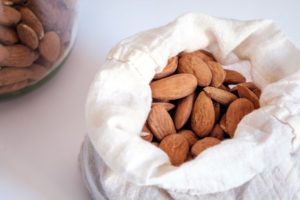The goods we purchase commonly come packaged in plastic and other non-recyclable materials. An easy way to make a dent in that plastic waste is to buy in bulk. Other benefits include less trips to the grocery store and overall cost savings.
How to get started with buying in bulk
Buying in bulk, whether it be food, clothing, or toiletries, is often cheaper than items purchased in smaller quantities. So, the eco-friendly packaging choice is often also the low-cost choice.
But before ordering grocery delivery, going to the store, or hitting up your favorite online retailer, it can help to understand your product needs for the next week or month. This will allow you to determine how much of each item you’ll need in the near future so you can maximize your bulk purchases and nothing goes to waste.
Buying food from the bulk food aisle
Most grocery stores carry a variety of scoop-your-own bulk options, such as coffee, tea, beans, rice, pasta, nuts, flour, sugar, granola, spices, honey, and oil. Check out what’s available before you choose pre-packaged options – you will be surprised at the variety of options. And to make your bulk aisle purchase even more eco-friendly, keep these two ideas in mind:
Come prepared with your own containers:
To further scale down your impact, take your own reusable containers or bags; some grocery stores provide scales for weighing containers before filling them. Large yogurt containers, glass pickle jars, and some plastic take-out containers work well for storing food as long as you make sure that they’re cleaned out and thoroughly dried to avoid food spoilage.
Take only what you need:
Buying in bulk allows you to minimize waste by choosing the exact quantity that you want, but since food can spoil, it’s important to take the amount you can use before it goes bad. Knowing how long foods typically last before spoiling will help you determine how much to get. Also, having a menu plan for the coming weeks will help you determine how much you need.
Buying from bulk bins isn’t the only way to cut down on packaging waste. Buying pre-packaged food in bulk is another option. Many grocery stores carry pre-packaged food in super-sized bags, bottles, cans, and boxes.
But single servings are handy, you argue? You can make your own individual servings when you get home by portioning that huge container of cheddar crackers into reusable bags or containers. This way you don’t have to send your kids to school with single-use plastics or food wrappers.

Source: functionofbeauty
Bulk-buying isn’t limited to food
Knowing the non-food items you use frequently and in abundance can also save you time, money, and resources. Many everyday products come in a super-sized containers — shampoo, cleaning supplies, auto supplies, underwear, and toilet paper are all examples of products that come in bulk. You can also consider capsule size cleaning or hygiene products, extending the life of your containers.
And remember, some companies allow you to bring clean, used containers in for re-filling, so check out these options the next time you’re in your local retailer.
Be warned – research before you buy
Buyer beware of bulk items in individual sheep’s clothing. Watch out for multiple small items packaged together that masquerade as ‘bulk’ options (three small bottles of shampoo shrink-wrapped together or flats of single-serving juice boxes rather than family-sized options, for instance). These don’t actually reduce the total packaging you’re taking home.
 Buying in bulk helps you on your quest to zero waste because…
Buying in bulk helps you on your quest to zero waste because…
- It reduces the amount of waste created.
- It prevents resources from being used to create unnecessary packaging.
Packaging of all sorts makes up about one-half of all solid waste in the municipal waste stream. Although at least 28 countries currently have laws designed to encourage reduced packaging, the US is not one of them. Instead, the burden of disposing of packaging waste is left to the consumer. While access to curbside recycling programs has increased from 30 percent to 73 percent between 1992 and 2017, many residents are not educated on what can go into their recycling bin.
Consider, too, that most purchases add additional package-waste by being bagged in plastic as they leave the store. A plastic bag, which takes only one second to manufacture, is used for about 20 minutes on average and then takes nearly 400 years to degrade naturally. About 160,000 of these bags are distributed worldwide every second.
But waste from spoiled food is also a problem. In addition to package waste, 22 percent of the solid waste stream comes from discarded food from commercial and residential sources. So efforts to both reduce purchased unwanted food (and the packaging it comes in) up front it essential when trying to reduce your eco-footprint.
Subscribe to receive more zero waste tips.



